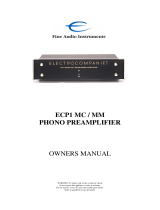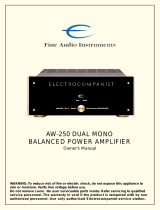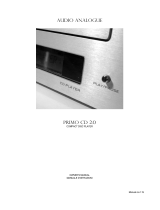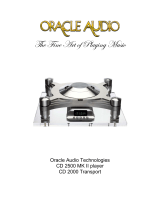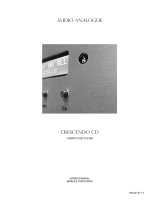Page is loading ...

Owner’s Manual
EMC 1 Reference CD Player
Warning:
To avoid risk of fire or electric shock, do not expose this appliance to rain or moisture.
Verify line voltage before use.
Do not remove cover. No user serviceable parts inside. Refer servicing to qualified service personnel.
The warranty is void if the product is tampered with by non-authorised personnel.
Use only authorised Electrocompaniet service center.

Welcome to the World of Electrocompaniet
We thank you for choosing an Electrocompaniet high-end product.
The Electrocompaniet EMC 1 will bring you many years of wonderful music reproduction
true to your favourite master recordings. Please take the time to read this manual to get
optimum performance from your new CD Player.
The Electrocompaniet Story
Electrocompaniet was founded in 1973 in Oslo, Norway, to manufactured an amplifier
designed by Per Abrahamsen. The design was based upon a new approach to transistor
amplifier design developed by Dr. Matti Otala and Jan Lohstro.
It had long been recognised that transistor amplifiers had a characteristic sound that many
audiophiles and music lovers found unnatural.
Dr. Otala and Mr. Lohstro analysed transistor amplifiers to determine what actually created
the “transistor sound” in general transistorised designs.
The results of their innovative design work were incorporated in the first Electrocompaniet
design - the legendary 25-watt amplifier.
It was the first commercial transistor amplifier to use this new design approach.
The amplifier was immediately recognised as dramatically more musical than any other
transistor amplifier at the time.
This design philosophy has been constantly updated through continuous research and
development. The philosophy prevails with all Electrocompaniet products.
Skilled technicians and craftsmen carefully create all Electrocompaniet products.
The products are extensively tested for maximum performance and reliability.
Electrocompaniet has always given the highest priority to extensive listening test for all its
designs. Every product designed by our engineers must meet a variety of exacting stan-
dards, set by a listening panel that is carefully selected to represent a cross- section of
musical taste and experience. Electrocompaniet designs go back and forth between the
design laboratory and the listening panel until both the engineers and the listeners are
satisfied with the end results.
Our quality products are sold throughout the world and provide the ultimate in listening
pleasure to discriminating music lovers.

Design Concept and Construction
The basic design philosophy of the EMC 1 CD transport is inspired by crucial knowledge
ported from the analogue turntable.
Principally, there is no difference between a record player and a CD player.
Both playback systems consist of: a motor, a pick-up and a tone arm. Phenomena such as
tone arm resonance’s found in analogue turntables are just as problematic in typical CD
Players.
To reduce or remove these phenomena plus other unwanted resonances,
Electrocompaniet has developed a proprietary mechanical filter, which has been frequ-
ency-adjusted by our listening panel in numerous listening tests. The mechanical filter
removes internal and external vibration components from entering the laser pick-up
assembly, resulting in a superior reproduction with tighter bass, bigger sound stage,
precision, high resolution and amazing detail.
The D/A converter is a sophisticated balanced 24-bit 96 KHz unit. Due to the higher
sampling frequency, the bandwidth is moved one octave up in frequency compared to
standard CD systems using 44,1 KHz sampling frequency.
All analogue circuits are fully balanced and symmetrical, similar to the design of our
amplifiers.
Four separate power supplies using Floating Transformer Technology (FTT) feed the digital
unit, the display, the drive mechanism and the analogue unit.

Unpacking the CD Player
Immediately upon receipt of the EMC 1 CD Player; inspect the carton for possible damage
during shipment. The carton and packaging have been designed to provide the safest
possible protection when transporting your CD Player.
Unpack the CD Player carefully. Save all packaging materials for future shipment.
The Content of the Carton
1 pcs Electrocompaniet EMC 1 CD Player
1 pcs AC power cord
1 pcs spare 1 Ampere Slow Blow Mains Fuse. (See page 11 for change of blown fuse)
1 pcs CD clamp
1 pcs Owner’s Manual
1 pcs self-adhesive felt ring for placement of the CD clamp when not in use
2 pcs Allen keys for securing of the Electro Mechanical Cancellation System
Set-up Procedure
Before connecting to Mains check that the mains voltage printed on the rear panel of the
CD Player corresponds to the line voltage in the territory were you intend to use the unit.
How to avoid damages
A good operating practice is to turn off all equipment before any connections or
disconnections are made. Do not under any circumstances connect or disconnect
equipment when power is turned on. The design of the RCA plug generates a huge
transient when inserted. Connecting or disconnecting equipment with the power on could
severely damage both speakers and amplifier(s).
How to avoid noise problems
The EMC 1 contains delicate circuits that are sensitive to magnetic strayfields.
The unit should not be place near mains transformers, TVs etc. Care should also be taken
regarding placement of the interconnect cables. Do not run interconnect cables in parallel
with mains cords and loudspeaker cables. Keep interconnect cables as short as possible.

1
For maximum performance, the
EMC 1 must be level.
Place the CD Player on a level
plane surface. Make all
connections on the rear panel.
2
Unscrew the Allen screws
holding the gold sign marked
“Mechanical Cancellation
System” with the small Allen key.
Loosen the transport fixing
screw that is located underneath
the gold sign with the large Allen
key. Unscrew it counter
clockwise. Put the gold sign
back and tighten the small Allen
screws.
Important!
Keep the Allen keys and spirit level in a safe place for future use.
Always tighten the transport screw when moving the CD Player.
The damping scales in the EMC 1 weigh eight kilograms.
If not securely fastened, the CD Player will be severely damaged, resulting in void of warranty.
Do not over-tighten the transport screw.

Front and Rear Panel Controls
The power on/off button is localised just above the mains connector on the rear panel.
Generally, we recommend that you to use the Standby button located on the front panel, or
as an alternative, use the remote control.
The display will go dark. The e- sign on top of the unit will still be lit, indicating Standby mode.
When not using the EMC 1 for a long period, turn the mains switch off and disconnect the
unit from the mains outlet.
The four buttons on the right front panel have the following functions:
Top button = start/play
Right button = next
Left button = previous
Lower button = stop
How to Power up Your System
You should always power up your system in the following way:
Signal sources (CD Player, tuner etc.) and preamplifier first. Allow 30 seconds warm-up
before you turn on the power amplifier(s).
When turning off your system:
Start with the power amplifier(s), then the preamplifier, and finally the signal sources.
Loading a Disc
Load the disc by gently pushing the drawer marked “ELECTROCOMPANIET” towards the
rear of the unit. “Open” is shown on the display. Place the disc on the spindle. Then place
the CD-clamp on the spindle. The clamp now securely fastens the disc. Pull the cover all
the way home. The CD Player must first read and load vital information from the disc. This
process, indicated by a flashing display, takes approximately three seconds. Tracks and
total time are displayed. Press start/play and the first track starts to play. When changing a
disc, press the stop button on the front panel or on the remote control before opening the
drawer.
If the drawer is opened during playback, it will take the disc a few seconds to spin down.
Do not touch the disc until it has come to a complete standstill.
Warning:
The laser pick-up is located behind the spindle.
NEVER look directly into the laserbeam!!!
Under normal circumstances the laser needs no cleaning.
Do not use any kind of “cleaning CDs”!

Remote control
1. STANDBY
2. DISC – No function.
3. SCAN – Play 10 seconds of each track.
4. PROG
a. Set the CD player in STOP MODE.
b. Select tracks with the numeric buttons (9), or step to the number using buttons
no. 14 or 15.
c. Press the PROG (4) button – the track is programmed.
Repeat b and c until all the tracks you wish to program is done.
After each track is programmed, the total playtime will be shown in the display.
If a track with number higher than 13 is programmed, the total playtime will not be
shown.
You can browse through the tracks with the buttons 14 and 15. On the tracks that
already are programmed, you will see a “P” shown in the display.
If you wish to remove a track from your program, choose the track number and
press PROG (4).
To monitor what is being programmed. Go back to STOP MODE.
Press PROG (4) – The display will now show the programmed tracks in the new
order.
The tracks are now stored in the order you programmed them and not in the
original numeric order.
If you press STOP (17) two times your program sequence will be erased.
5. FAST – press this button before you use the search buttons (6 or 13). The search
will go faster.
6. SEARCH BACKWARDS
7. A/B – Repeat a segment of the disc/track. Press the button once to mark the start
of the portion to be repeated. Press it again at the end of the desired sequence.
The selected area will play continuously until the STOP (17) button is pressed.
8. SHUF - The tracks will be played in a random order.
9. REP – Press this button once and all the tracks on the disc will be repeated.
The display will show “REPEAT”.
Press the button again, and it will only repeat the current track.
The display will show “REPEAT 1”
10. PAUSE – Pause on/off.
11. NUMERIC CONTROLS – Press these buttons to select a specific track on the disc.
For tracks 10 and above, the second digit of the number must be pressed within
one second.
12. TIME – Press once. In normal operation, the display will show the running time of a
track being played. Press the button once to check the time remaining for the track
in play. Press the button again to view the total playing time of the disc being
played.
13. SEARCH FORWARD
14. NEXT TRACK
15. PREVIOUS TRACK
16. PLAY
17. STOP

Replacing a blown Mains Fuse
Always remove the AC cord from the AC inlet.
The mains fuse is located in a small drawer
inside the AC inlet of the unit.
If, for some reason the fuse is blown, turn the
unit off, and remove the AC cord from the AC inlet.
Open the drawer with a small screwdriver and
remove the blown fuse.
The spare fuse is located inside a holder in
front of the mains fuse.
1. Remove and discard the blown fuse.
2. Remove the spare fuse gently by pushing
it sideways out of its holder.
3. Insert the spare fuse as the main fuse.
4. Push the drawer gently back to closed
position.
5. Re-insert the AC cord and turn the unit on.
Never replace the fuse with other
values than indicated on the unit!
Replacing Remote Control Batteries
Replace exhausted batteries by gently inserting your fingernail or small screwdriver in the
groove on the left side of the battery compartment cover. Lift the cover off, and insert a fresh
set of batteries as indicated by the diagram below. Be careful to follow the + and – polarity
indications at the bottom of the battery compartment.

Technical Specifications EMC 1
Analog stage
Output level (unbalanced) 1,6 V
Output level (balanced) 3,2 V
Gain (unbalanced) 1.6 X (4 dB)
Gain (balanced) 3.2 X (10 dB)
Maximum output (balanced) > 14 V RMS
THD (1 V out, 1 kHz) < 0.002 %
Channel separation ( 1 V out, 1 kHz) > 90 dB
Equivalent input noise 4 uV
Output impedance 100 Ohm
Analog filter (-3 dB) 75 kHz
Digital stage
Dynamic range 100 dB
Signal to noise 100 dB
THD -100 dB
Frequency response 20 Hz - 20 kHz
Input / Output impedance (fixed) 75 Ohm
Sampling frequency in 32 - 48 kHz
Mains voltage 120V / 240V
Power consume 23 W
Dimensions
Width 483 mm (19 inches)
Depth 450 mm (17.7 inches)
Height 120 mm (4.7 inches)
Weight 20 kg (44 lbs..)
Specifications subject to change without notice.

Important Notice
For optimal sonic performance, the EMC 1 should be burned in for a minimum time of 72 hours.
The easiest way to burn in your EMC1 is to put a disc in REPEAT mode with the rest of
your system turned off.
In daily operation, switch off the CD Player by using the STANDBY button on either the
remote control or on the front panel.
If the CD Player has been switched off by the MAINS button on the rear panel, allow two
hours of warm-up to optimise sonic performance.
Due to high class A operation in all Electrocompaniet designs, it is normal for the CD
Player to feel warm. Proper ventilation is important. The CD player should by no means be
completely covered.
A good rule of thumb is to allow at least 3 – 5 cm (1 - 2 inches) of air sidewise, and 5 – 8
cm (2 - 3 inches) above the CD Player.
Please refer to Owner’s Manual for removal of the CD transport screw. The transport screw
must be removed for proper operation.
When moving the CD Player. Always re-insert and tighten the transport screw to avoid
severe damage to the unit!!!

Service Policy
If Service is needed
Your dealer will have all relevant information regarding the service centers in your area
and will ensure that your unit is serviced without delay.
It is our general policy to have your unit returned to you within 5 working days. This is an
average time, and could vary locally, depending on the work load at the service center.
If, for some reason, there are no service facilities available in your country, please ship the
unit to the following address:
Electrocompaniet A/S
Solheimsveien 36 1473 SKÅRER
Phone: +47 67 91 17 66 Fax: +47 67 91 17 60
E-mail: [email protected] Web: http//www.electrocompaniet.no
The end- user is responsible for all shipping charges, insurance, reimportation and duty
charges. When shipping a product to the factory for service, always include the following:
1. A sales slip or other proof of purchase if repair is claimed under warranty.
2. A proforma invoice with value of goods, stating that the amplifier is returned to
Norway for repair.
3. An accompanying letter describing faults, symptoms, or problems with the unit.
4.Always ship the unit in its original carton and packaging material to prevent
damage in transit. Electrocompaniet will not cover damages incurred in transit.
PLEASE REMEMBER TO FASTEN THE TRANSPORT FIXING SCREW!
If you require further information concerning the operation of the unit, or if you have any
questions related to service, please do not hesitate to contact your dealer or national
Electrocompaniet distributor.
/
